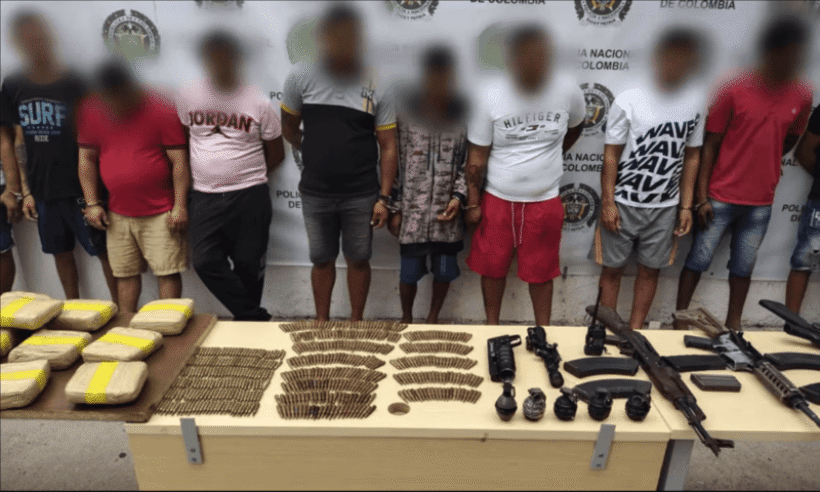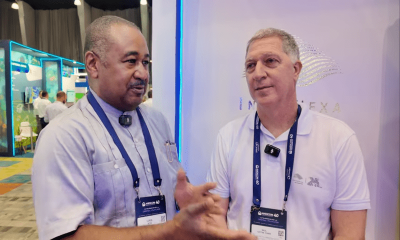Insight Crime: How Venezuela’s Tren de Araguá Has Fought To Displace Colombian Mafias
In the early hours of July 1, 2024, an elite corps of Colombian police suited up and loaded their automatic rifles, aiming to end their hunt for one of the most wanted men in Latin America.
After several months of tracking and surveillance, Colombian security forces arrested Larry Amaury Álvarez Núñez, alias “Larry Changa,” leader and co-founder of Tren de Aragua, the Venezuelan-born criminal organization with tentacles across different countries. He was hiding in a luxurious mansion he built from the ground up, in an exclusive rural area of the municipality of Circasia, in the department of Quindío. A security ring of nine bodyguards usually protected him and drove a luxury vehicle around the coffee-growing region.
“‘Larry Changa’ would have arrived in Colombia in 2022, obtaining false documents. He was in charge of the criminal strategy for the territorial expansion of the ‘Tren de Aragua’ in Colombian territory,” the Colombian Ministry of Defense posted on its X account.
Larry Changa, according to Chilean prosecutors and Colombian police who spoke to InSight Crime, was initially responsible for the establishment of Tren de Aragua cells in Chile and the wider logistical deployment in the south of the continent. After his presence was detected by Chilean security agencies, he had to flee and seek a new refuge.
His arrival in Colombia was just another chapter in Tren de Aragua’s continental expansion.
In addition to being the first choice of the nearly eight million Venezuelan migrants who have fled economic collapse, Colombia had already proven to be fertile territory for Tren de Aragua’s operations, expanding its criminal rents and offering refuge to some of its most notorious leaders.
Hiding among more than two million Venezuelans in Colombia, Tren de Aragua had been putting down roots in different parts of the country, including the capital, Bogotá. But the most established strongholds are along the Colombia-Venezuela border, where the Venezuelan criminals charge tolls to migrants. Here, Tren de Aragua begins its exploitation of the exodus, the starting point for the human smuggling networks that extend across South America and northwards to the United States.
La Parada: Tren de Aragua Shows Its Face
The irregular border crossings, known as “trochas,” which allow millions of Venezuelan migrants to enter Colombia, also became strategic routes for the transnational advance of Tren de Aragua.
In 2018, according to authorities and residents consulted by InSight Crime, Tren de Aragua established its first bases in the township of La Parada, in the municipality of Villa del Rosario, in Colombia’s Norte de Santander department. Adopting a low profile, its members took advantage of the growing human flow to consolidate an illicit business that thrived amid the vulnerability of the passing migrants.
At that time, Colombia was home to more than a million Venezuelan migrants scattered across different regions of the country. Villa del Rosario, in particular, had consolidated itself as one of the main entry points, serving as a key corridor for the migratory flow from Venezuela.
“This is an attractive place for them because it is a point where illegality proliferates, especially in smuggling and trafficking of irregular migrants,” an officer from the Metropolitan Police of Cúcuta, the capital of Norte de Santander, who requested anonymity for institutional reasons, told InSight Crime.
Once settled in several different border neighborhoods in La Parada, Tren de Aragua began exercising strict control over the Los Mangos and La Marina trochas, among other clandestine trails. The gang began to dominate several illegal economies through the use of violence and terror.
Migrants became their main target. Since the group’s arrival in this border area and until 2022, the border was closed, and the main legal crossing point, the Simón Bolívar International Bridge. This forced thousands of migrants to use the trochas, exposing them to extortion and abuse. Tren de Aragua charged travelers a $10 toll to cross, while bus drivers carrying migrants had to pay up to $125 in “taxes.”
“Tren de Aragua controls the Colombian side. To travel to Bogotá and then to Quito, Ecuador, you have to pay a fee to that group,” said a resident of La Parada, who preferred not to reveal his identity.
In addition, the gang imposed curfews in the areas under their control and demanded weekly payments of between $10 and $15 from local merchants. Those who refused to pay faced brutal reprisals, such as the throwing of grenades or the use of indiscriminate violence, a Tren de Aragua hallmark. In some areas of La Parada, media reports and security sources revealed the existence of torture houses, where those who disobeyed the rules or did not pay extortion fees were punished.
Faced with the advance of Tren de Aragua and increased insecurity in La Parada and several neighborhoods of the city of Cúcuta, the security forces intensified their efforts, capturing several members of the organization, including some leaders and hired killers.
In addition to facing state action, Tren de Aragua has had to contend with superior criminal rivals.
Following an armed dispute between 2021 and 2022 with the National Liberation Army (Ejército de Liberación Nacional – ELN), the Colombian guerrilla group that dominates the criminal scene along the Colombian-Venezuelan border, a territorial division was created. Tren de Aragua was left controlling the Colombian side with no possibility of entering or doing business on the Venezuelan side, which remained under the control of the insurgency, acting with the blessing of the Maduro regime. The ELN was protected in Venezuela, but exposed to the security forces in Colombia.
Despite the state’s offensive and struggles with the ELN and other criminal groups, the gang continued to operate in Villa del Rosario and Cúcuta. Immersed in migrant smuggling, human trafficking, small-scale drug trafficking, prostitution, and extortion, they managed to consolidate themselves as one of the main criminal players in this part of the border.
SEE ALSO: With Venezuelan Criminal Groups Strengthening, Violence in Cúcuta Rises
Tren de Aragua’s criminal fiefdom at this crossing point allowed the entry into Colombia of other gangs of Venezuelan origin that were boosted by the reputation of Tren de Aragua.
Linked to more than 50 murders in Cucuta, according to official reports cited by the local press, the AK-47 gang, led by Jhoswar Saul Hernandez Sanabria, alias “Saul,” – captured in Venezuela – began as a satellite cell of Tren de Aragua before becoming independent. It currently operates in the center of the city, where it extorts merchants and has several drug sales points under its control.
The evolution of this faction, of Venezuelan origin, has escalated into a fierce dispute with other criminal organizations over control of the currency exchange houses. These financial operations, often used as a front for money laundering, have become points of friction. In addition, the recruitment of Colombians into their ranks demonstrates the gang’s ability to offer more attractive incentives than those of local criminal organizations.
Expanding Operations Beyond the Border
In the early morning hours of August 25, 2022, residents of a working-class neighborhood in Bogotá, Colombia, awoke to a gruesome scene. In the middle of the street, abandoned in a cart, were three corpses wrapped in black plastic garbage bags.
Leaving these bodies in public view was no random act. Behind the grim display was a violent territorial dispute between Tren de Aragua and local gangs for control over illicit activities in the Bogotá districts of Kennedy, Bosa, and Los Mártires.
Aníbal Fernández de Soto, then Bogotá’s security secretary, confirmed this in a statement. “The Tren de Aragua organization is the main group responsible for homicides in which bodies have been left in bags in public spaces in several areas of the city,” he said.
Between 2022 and 2023, local authorities documented at least 57 cases of people killed and found wrapped in garbage bags, many of them dismembered and showing clear signs of torture. It is unknown how many of these killings were directly carried out by Tren de Aragua.
The gang’s extreme violence was key to securing its place in the Colombian capital’s criminal underworld.
In its first phase, the group infiltrated Bogotá’s local criminal organizations, triggering a wave of betrayals that ended with its takeover of gangs like the Camilos. This conflict, which left more than 36 dead, allowed the Venezuelan group to consolidate control in strategic areas of Bogotá, including the commercial hub known as Corabastos and retail drug sale points in Kennedy and Ciudad Bolívar.
“To grow, they first ally with other criminal structures. That’s what happened when Tren de Aragua began to emerge in Aragua state and later extended its influence by partnering with organizations in other states to increase its criminal profits,” an investigator with Colombia’s anti-kidnapping and anti-extortion police unit told InSight Crime.
One faction that followed this strategy was the gang led by José Manuel Vera, alias “Satanás.” Initially operating as a satellite of Tren de Aragua, the group eventually gained enough manpower and illicit revenue to break away and form an autonomous network focused on extortion and microtrafficking in several Bogotá neighborhoods.
Although Satanás was arrested in Ecuador in November 2023 and extradited to Colombia, his criminal influence did not end. From inside the Palogordo prison in Santander department – and with the complicity of corrupt guards – his network remained active, using contraband cell phones to extort victims and keep cash flowing. Even behind bars, his power remained intact.
Corruption inside the security forces also impacted the streets of Bogotá.
In early 2023, a joint intelligence operation by the police and the Attorney General’s Office uncovered Tren de Aragua’s infiltration of the capital, identifying one lieutenant and five noncommissioned officers on the gang’s payroll. These police officers provided a range of services to the transnational network, including protecting leaders, collecting extortion payments, selling confidential information, and issuing safe conducts to control areas of sexual exploitation and small-scale drug trafficking in Kennedy.
Colombian authorities have continued investigating the group. In Bogotá, they also discovered that the gang owned several nightclubs used to launder proceeds from its criminal activities. The parties held in these venues – which featured international DJs – helped boost its other businesses, especially retail drug trafficking. The logistical coordinator of these operations, identified by the alias “Eryk,” was arrested in October 2024 after months of investigation.
While Tren de Aragua’s attempts to expand into other parts of the city have been thwarted, the gang has achieved a degree of consolidation in its strongholds in the capital. At the same time, efforts to enter other Colombian departments have failed, particularly in areas where they have encountered more experienced and better-established local criminal structures.
Putting the Brakes on Criminal Greed
After establishing an effective grip on certain territories and illicit economies in Bogotá and Norte de Santander, Tren de Aragua sought to replicate its model in other parts of Colombia.
However, this expansion has been hindered by the presence of more heavily armed local criminal groups and the response of security forces.
Unlike Bogotá, where criminal control is more fragmented, Medellín – famous as the cradle of Pablo Escobar’s drug trafficking empire – has resisted Tren de Aragua’s advance, thanks in part to a consolidated criminal underworld unwilling to cede territory.
“In Medellín, we’ve found it striking, especially compared to other cities, that they haven’t managed to break in,” a police investigator told InSight Crime in 2024.
Security experts consulted for this investigation, including Hugo Acero, former Bogotá security secretary, say the level of criminal governance exercised by structures like the Oficina de Envigado – a federation of criminal organizations that began as a hitman-for-hire network in the 1980s under the Medellín Cartel – prevents new players like Tren de Aragua from putting down roots in this city.
However, the gang did not give up. In Medellín’s busy streets and entrenched criminal underworld, the city has seen multiple Tren de Aragua members seek refuge in 2025 — only to be found by authorities or killed by rival criminals. These opportunities, during which they have also explored the potential of local criminal markets, show the gang’s ongoing interest in Colombia’s second city.
In one case in late July, two alleged members who had arrived in March from the United States used their stay to traffic weapons and sell synthetic drugs, according to Colombian police investigations.
SEE ALSO: Colombia Nabs Another Top Tren de Aragua Leader With Venezuela’s Help
Beyond Medellín, Tren de Aragua and other Venezuelan-origin gangs have also faced resistance in other parts of Colombia.
In 2021, the discovery of a corpse bearing a sign reading “killed for being from Tren de Aragua” revealed the resistance they encountered in Arauca, a border region known for drug and migrant trafficking. Their main rivals there were dissident elements of the now demobilized guerrillas of the Revolutionary Armed Forces of Colombia (Fuerzas Armadas Revolucionarias de Colombia — FARC), whose experience and military power thwarted the Venezuelan group’s push into this border region.
In addition to FARC dissidents, Arauca is an ELN stronghold, making it an extremely difficult area to penetrate. Tren de Aragua could not replicate its border-expansion strategy there, as it did in Villa del Rosario, unable to defeat two very powerful Colombian criminal structures.
Even so, Tren de Aragua appears to have identified the potential of other areas in Colombia not as places to install a criminal presence, but as safe havens amid heightened security force pressure.
Several major arrests of the group’s leaders have occurred in towns and departments where the group has no visible operations. Instead, members have focused on investments in rural areas in the country’s interior. This was the case with Larry Changa, who was arrested at a mansion under construction in an exclusive sector of Circasia, in the Colombian department of Quindío, driving a luxury vehicle.
Another leading figure in Tren de Aragua’s Chilean operations was also arrested in Colombia. In December 2024, police captured Carlos Francisco Gómez Moreno, alias “Bobby,” in Los Patios, a municipality bordering Villa del Rosario in Norte de Santander. Chilean prosecutors say Bobby is one of Tren de Aragua’s leaders in Chile, suggesting Colombia may have become both a base of operations and a hideout for the gang’s international leadership.
Also noteworthy was the arrest of gang member Jeison Alexander Lorca Salazar, alias “Jeison Comino,” found at a luxury ranch in Los Santos, in the Santander department.
The movements of these Venezuelan criminals have not gone unnoticed. Colombian security forces have actively worked to prevent these transnational organizations from gaining ground in the country, establishing cooperation mechanisms with neighboring nations where Tren de Aragua operates. In some cases, they have even received help from the Venezuelan government, as in the capture of Jeison Comino.
That arrest was billed as a high-level operation, with Jeison Comino described as the gang’s second-in-command. In reality, the criminal, who had been active in Venezuela, was a lieutenant in the gang of El Conejo, one of Tren de Aragua’s satellite groups in Aragua state that weakened after its leader died in 2023.
The lack of reliable, verified information – partly due to the absence of Venezuelan cooperation and the low credibility of the little information they do share – leads to inflated claims about arrests and the gang’s reach.
Even so, other significant captures have dealt real blows to the group’s Colombian expansion, such as that of Salomón Fernández Torres, alias “Salomón,” on June 27, 2024. A top confidant of Niño Guerrero and the group’s financial chief in Bogotá, he was arrested as part of a series of operations by police and prosecutors that, by June 2024, had led to more than 240 Tren de Aragua members being detained.
Authorities now have their sights set on Giovanny Vicente Mosquera Serrano, alias “Giovanny San Vicente,” considered the gang’s top coordinator in Colombia and a liaison between its factions abroad. US authorities have offered a reward of up to $3 million for information leading to his arrest.
But just as the movement of migrants did not stop in Colombia, neither did Tren de Aragua’s operations.
Members of the organization moved into the municipality of Ipiales, in Nariño department at Colombia’s southern border— a strategic point on the migration route to Ecuador, Peru, and Chile — where they profited from migrant flows and extorted locals, according to leaked emails and documents from Colombia’s Attorney General’s Office in what became known as the NarcoFiles project.
Tren de Aragua’s next stop on the migrant trail to the south, Peru, offered a criminal market ripe for extortion, fueled by a growing Venezuelan migrant community that allowed the gang to establish itself. In a less crowded criminal landscape, with less experienced security forces and an unstable political climate, Tren de Aragua was able to flourish like never before.
This article, written by the Venezuela Investigative Unit, was originally published by InSight Crime, a Medellín-based foundation dedicated to the investigation and analysis of crime and security in Colombia and Latin America. It has been generously shared with Finance Colombia under a Creative Commons license.




























